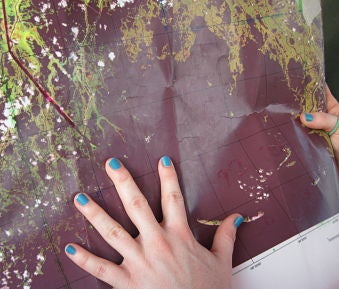
La página que intenta visitar sólo está disponible en inglés. ¡Disculpa!
The page you are about to visit is currently only available in English. Sorry!


Allison Manning, an LSU grad student, inspects the turbidity of a tube of Terrebonne Bay water. She is the only person in Louisiana studying dolphin populations. With present population numbers unknown, we will never know how the spill affected dolphins. (Photo by Justin Nobel/Audubon Magazine; Photos taken under the authority of NMFS Letter of Confirmation No. 919-1797)
Terrebonne Bay, Louisiana, June 8
Fishermen are banned from these waters because crude oil lurks nearby but we are here, searching for dolphins. And we see plenty, frolicking in pods of six or eight, some with newborn babies. They chase schools of fish invisible to us and communicate through trills and clicks inaudible to us, a language we try and capture with a hydrophone. I ask Louisiana State University graduate student Allison Manning, who is surveying the bottlenose dolphins in Terrebonne Bay, some 100 miles from the Deepwater spill site, if they are in jeopardy.
“Think about it this way, they closed fishing and shrimping here to humans,” she says. “And dolphins are at the same level of the food web as we are.”
One would expect a flock of scientists studying the populations of these august beasts but actually in Louisiana, Manning is the only one. Her survey will be the first in-depth population assessment of dolphins anywhere in the state in nearly a decade. In some spots, like at the mouth of the Mississippi River where oil is thick dolphin numbers are entirely unknown. This black hole of dolphin data is problematic. Dead dolphins are showing up, 38 have stranded since April 30th, a figure that is well above average, but there are countless more that will never be found, adrift or sunk in the sea. The fact is that without accurate numbers for how many dolphins there are now, we will never know how many were affected by the spill.
“We ultimately don’t know what kind of threat the oil spill is going to have on the dolphins,” says NOAA marine mammal biologist Erin Fougeres. “I would say we are very concerned.”
Immediately after the rig exploded, birders hit the beach to conduct baseline population surveys, data that could reveal how many birds went missing in the spill when sites are surveyed again next year. All surveyors needed were binoculars and a bit of birding know-how; dolphins are much more difficult to survey. You need a well-fueled boat, a NOAA permit and tons of time and money. To identify dolphins, researchers snap countless photos of fins, pictures that are later scrutinized for scars and marks to distinguish individuals. One place with good dolphin data is Sarasota, Florida, where the Sarasota Dolphin Research Program has been studying local populations for four decades. But in Florida there is greater dolphin awareness; the animals represent an NFL team and waters are crystal clear, making dolphins easier to spot by beachgoers and boaters. Louisiana’s coastal waters are murky and less accessible. People are focused on marine life but it tends to be the commercial creatures like crab, snapper and shrimp, says Manning.
No one knows yet whether the recently stranded dolphins were killed by oil or not. Strandings were high in March, before the spill, and NOAA is still trying to figure out why. Current figures could also be high because more people are looking. Even the dolphin smothered in crude that washed ashore on Queen Bess Island, in Barataria Bay, last week, may have died before it was oiled, says Fougeres. NOAA won’t know for sure until tissue samples taken from the dolphin can be analyzed. Not much is known about exactly how oil kills marine mammals. At least some killer whales in Alaska were suspected to have inhaled fumes emitted by spilled Exxon Valdez oil, causing them to lose consciousness and drown. Oil can burn the mucous membranes around the eyes and mouth, says Fougeres. Inhaled fumes can cause pneumonia, ulcers and liver and kidney failure.

Terrebonne Bay, some 100 miles from the Deepwater spill site, is off-limits to fishermen but loaded with dolphins. No one knows exactly how many. (Photo by Justin Nobel/Audubon Magazine; Photos taken under the authority of NMFS Letter of Confirmation No. 919-1797)
Back on Terrebonne Bay, we break for lunch near Whiskey Island, a pelican haven now enveloped by yellow boom. A pod of dolphins swims past, then another. Nearby are a group of barges and shrimp trawlers, some of the only boats on the water. They are unloading immense coils of boom. In calm seas it can block oil at the surface, but researchers have found oily plumes underwater, where dolphins obviously spend the majority of their time.
After lunch, we resume the search for dolphins. Manning is committed to get more data before afternoon storms split the sky. “I think it’s critical to figure out how many dolphins are out there,” she says. “How else are we going to know what harms them?” The answer, sadly, is we aren’t.
Justin Nobel/Audubon Magazine.